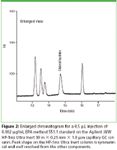Chlorinated Solvents and Disinfection By-product Analysis Using Agilent J&W HP-1ms Ultra Inert and DB-1301 Capillary GC Columns
Trace-level chlorinated hydrocarbon analyses using methods such as U.S. EPA Method 551.1 are important tools for assessing organochlorine contamination in water. The wide diversity of target organochlorine compounds can prove chromatographically challenging due mainly to their high volatility and limited retention. This application note shows the benefits of using an Agilent J&W HP-1ms Ultra Inert Capillary GC column as the primary column for detection in this dual-column analysis.
Doris Smith and Ken Lynam, Agilent Technologies, Inc.
Trace-level chlorinated hydrocarbon analyses using methods such as U.S. EPA Method 551.1 are important tools for assessing organochlorine contamination in water. The wide diversity of target organochlorine compounds can prove chromatographically challenging due mainly to their high volatility and limited retention. This application note shows the benefits of using an Agilent J&W HP-1ms Ultra Inert Capillary GC column as the primary column for detection in this dual-column analysis.
The disinfection of water for safe human consumption is a critical process worldwide. Chlorination is an effective means of achieving water disinfection, but has been shown to produce a wide variety of disinfection by-products (DBPs). These by-products are formed when the chlorinated disinfectant reacts with naturally present organic matter. Some of the by-products formed include trihalomethanes (THMs), haloacetonitriles, and chloropropanones. Many of the DBPs have been linked to adverse health effects, including birth defects, bladder, and colon cancer. Because of these health concerns, the levels of the by-products are monitored to ensure they are below safety standard limits.
A standard preparation containing chlorinated solvents, THMs, and other disinfection by-products (DBPs) was analysed to evaluate column performance. This analysis used simultaneous primary and confirmation analysis from a single injection source through an Agilent Capillary Flow Technology two-way splitter without make-up device. The primary analysis column used was an Agilent J&W HP-1ms Ultra Inert 30 m × 0.25 mm × 1.0 μm and the confirmation column was an Agilent J&W DB-1301 30 m × 0.25 mm × 1.0 μm.
Experimental
An Agilent 7890A GC equipped with dual μECDs and an Agilent 7683B automatic liquid sampler was used for this series of experiments. The chromatographic conditions used for these analyses are listed below.

Results
In this application note, a six-level calibration curve set was evaluated over the concentration range of 0.002 to 0.1 μg/mL using simultaneous confirmation of a single injection. A two-way splitter without make-up capillary flow device (Agilent PN G3181B) was used to split the sample onto the two columns. Figure 1 shows a chromatogram for the 5 pg on column loading from a single injection of the EPA 551.1 standard on the primary and confirmation columns.

Figure 1
Excellent peak resolution and peak shape were obtained on both the HP-1ms Ultra Inert and the DB-1301 columns. Chloral hydrate is unstable and does not resolve as a discreet peak as a result of selectivity on a 1301 phase column. Figure 2 shows that chloral hydrate is well resolved and has symmetrical peak shape even at low levels on the HP-1ms Ultra Inert primary column.Linearity was excellent across the range studied, giving R2 values of 0.998 or greater for the chlorinated analytes on both the primary analysis column and the confirmation column.

Figure 2
Conclusions
This application successfully demonstrates the use of an Agilent J&W HP-1ms Ultra Inert capillary GC column for primary analysis of chlorinated solvents, trihalomethanes, and disinfection by-products. Linearity was excellent for all organochlorine analytes studied, yielding 0.998 or greater R2 values down to a 0.5 pg on-column loading. One of the reasons for the excellent linearity and high R2 values is the highly inert surface of the column. The excellent peak shape of the chloral hydrate and resolution emphasize the lack of chemically active sites of this column, makes the HP-1ms Ultra Inert column an excellent choice for trace level chlorinated hydrocarbon analyses such as EPA Method 551.1.

Agilent Technologies, Inc.
2850 Centerville Road, Wilmington, DE 19808
tel. (800)227-9770; fax (302)633-8901
Website: www.agilent.com

Separation of Ultra-Short and Long Chain PFAS Compounds Using a Positive Charge Surface Column
December 11th 2024A separation of ultra-short and long chain PFAS (C1-C18) is performed on a HALO®PCS Phenyl-Hexyl column along with a HALO®PFAS Delay column which demonstrates excellent retention for both hydrophilic and hydrophobic analytes.

.png&w=3840&q=75)

.png&w=3840&q=75)



.png&w=3840&q=75)



.png&w=3840&q=75)














